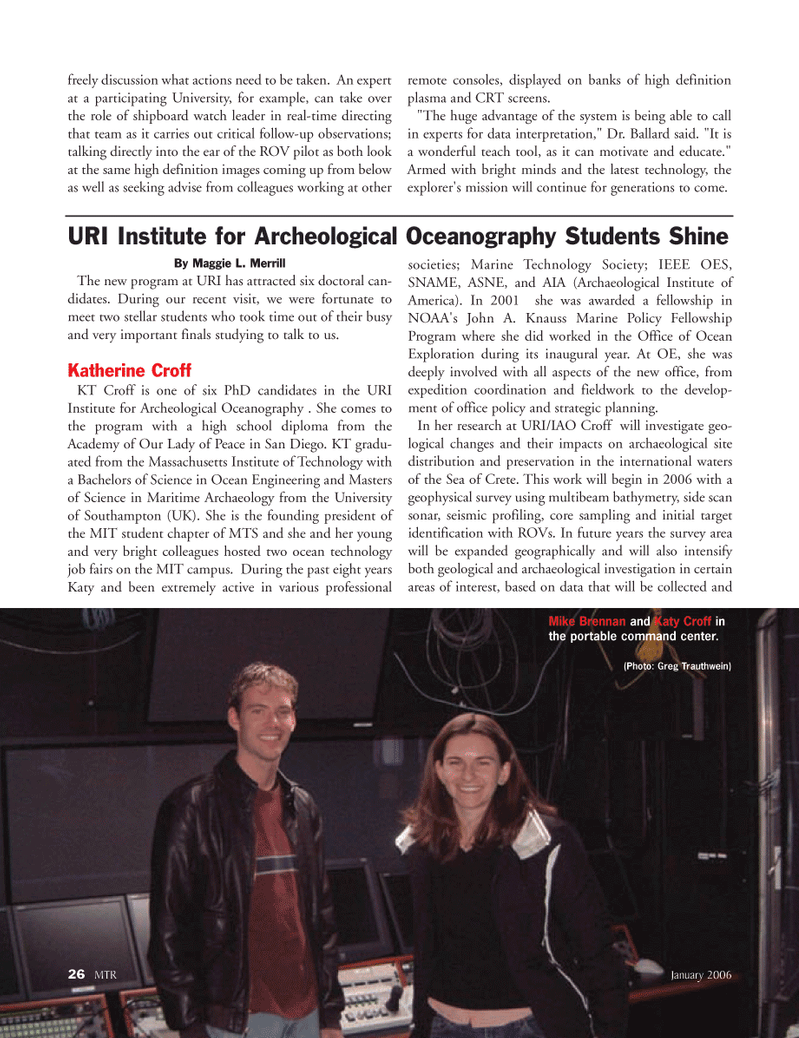
Page 26: of Marine Technology Magazine (January 2006)
Marine Science Institutions
Read this page in Pdf, Flash or Html5 edition of January 2006 Marine Technology Magazine
26 MTR January 2006 freely discussion what actions need to be taken. An expert at a participating University, for example, can take over the role of shipboard watch leader in real-time directing that team as it carries out critical follow-up observations; talking directly into the ear of the ROV pilot as both look at the same high definition images coming up from below as well as seeking advise from colleagues working at other remote consoles, displayed on banks of high definition plasma and CRT screens. "The huge advantage of the system is being able to call in experts for data interpretation," Dr. Ballard said. "It is a wonderful teach tool, as it can motivate and educate."
Armed with bright minds and the latest technology, the explorer's mission will continue for generations to come.
By Maggie L. Merrill
The new program at URI has attracted six doctoral can- didates. During our recent visit, we were fortunate to meet two stellar students who took time out of their busy and very important finals studying to talk to us.
Katherine Croff
KT Croff is one of six PhD candidates in the URI
Institute for Archeological Oceanography . She comes to the program with a high school diploma from the
Academy of Our Lady of Peace in San Diego. KT gradu- ated from the Massachusetts Institute of Technology with a Bachelors of Science in Ocean Engineering and Masters of Science in Maritime Archaeology from the University of Southampton (UK). She is the founding president of the MIT student chapter of MTS and she and her young and very bright colleagues hosted two ocean technology job fairs on the MIT campus. During the past eight years
Katy and been extremely active in various professional societies; Marine Technology Society; IEEE OES,
SNAME, ASNE, and AIA (Archaeological Institute of
America). In 2001 she was awarded a fellowship in
NOAA's John A. Knauss Marine Policy Fellowship
Program where she did worked in the Office of Ocean
Exploration during its inaugural year. At OE, she was deeply involved with all aspects of the new office, from expedition coordination and fieldwork to the develop- ment of office policy and strategic planning.
In her research at URI/IAO Croff will investigate geo- logical changes and their impacts on archaeological site distribution and preservation in the international waters of the Sea of Crete. This work will begin in 2006 with a geophysical survey using multibeam bathymetry, side scan sonar, seismic profiling, core sampling and initial target identification with ROVs. In future years the survey area will be expanded geographically and will also intensify both geological and archaeological investigation in certain areas of interest, based on data that will be collected and
Mike Brennan and Katy Croff in the portable command center. (Photo: Greg Trauthwein)
URI Institute for Archeological Oceanography Students Shine
MTR#1 (17-32).qxd 1/9/2006 2:29 PM Page 26

 25
25

 27
27
